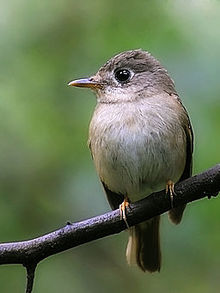Brown-breasted flycatcher
| Brown-breasted flycatcher | |
|---|---|

| |

| |
| Scientific classification | |
| Domain: | Eukaryota |
| Kingdom: | Animalia |
| Phylum: | Chordata |
| Class: | Aves |
| Order: | Passeriformes |
| Family: | Muscicapidae |
| Genus: | Muscicapa |
| Species: | M. muttui
|
| Binomial name | |
| Muscicapa muttui | |
| Synonyms | |
|
Alseonax muttui | |
The brown-breasted flycatcher or Layard's flycatcher (Muscicapa muttui) is a small passerine bird in the flycatcher family Muscicapidae. The species breeds in north eastern India, central and Southern China and northern Burma and Thailand, and migrates to southern India and Sri Lanka. It forages for insects below the forest canopy, often close to the forest floor.
Description[edit]
The brown-breasted flycatcher is 13–14 cm in length and weighs between 10-14 g. The overall colour of the upper parts is olive brown. Some of the feather shafts are darker. The upper tail coverts are brighter rufous as are the edges of the flight feathers. The tail feathers have rufous on the outer webs. The lores are pale and the eye ring is conspicuous. The chin and throat are white while the breast and sides of the body are pale brown. The middle of the body to the vent is buffy white.[3] Submoustachial stripes are faint but mark the boundary of the pale chin while the legs and lower mandible are pale flesh coloured.[4] The most similar species is the Asian brown flycatcher, which has black rather than pale legs.[5] It was named by Layard after Muttu, his servant[6] who brought him the specimen.[2]
Although no ringing evidence exists to prove their migration, it is thought that the winter migrants in southern India and Sri Lanka come from north-east India and northern Thailand. A subspecies stötzneri (incorrectly spelt as stotmani by E C Stuart Baker[7]) described from Szechwan by Hugo Weigold in 1922[8] appears to fall within the range of visible geographic variations and is not usually recognized.[4][9]
The usual call is very faint tseet audible only at close range or a series of notes chi-chi-chi-chi ending with a low chit-chit.[4]
References[edit]
- ^ BirdLife International (2016). "Muscicapa muttui". IUCN Red List of Threatened Species. 2016: e.T22709220A94197748. doi:10.2305/IUCN.UK.2016-3.RLTS.T22709220A94197748.en. Retrieved 12 November 2021.
- ^ a b Layard, EL (1854). "Notes on the Ornithology of Ceylon, collected during an eight years' residence in the Island". Ann. Mag. Nat. Hist. Series 2. 13: 127.
- ^ Oates, Eugene W. (1890). The Fauna of British India. Birds Vol. 2. Taylor and Francis, London. pp. 36–37.
- ^ a b c Rasmussen, PC & JC Anderton (2005). Birds of South Asia: The Ripley Guide. Volume 2. Smithsonian Institution & Lynx Edicions. p. 375.
- ^ Wait, WE (1922). "The passerine birds of Ceylon". Spolia Zeylanica. 12: 114.
- ^ Gould, John (1883). The birds of Asia. Volume 6.
- ^ Baker, E.C. Stuart (1930). Fauna of British India, including Ceylon and Burma. Birds. Volume VIII (2 ed.). London: Taylor and Francis. p. 632.
- ^ Weigold, Hugo (1922). "Zwei neue formen aus Westchina". Ornithologische Monatsberichte. 30 (3): 63.
- ^ Wells, D.R. (1983). "Brown-breasted flycatcher Muscicapa muttui in Thailand". Bulletin of the British Ornithologists' Club. 103 (4): 113–114.

